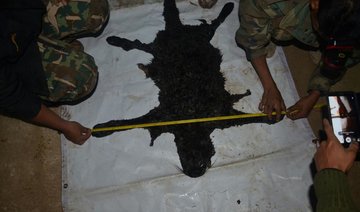NAYPYIDAW, Myanmar: Elephant skins, clouded leopard remains and tiger bones were among a $1.3 million haul of illegal wildlife incinerated Thursday in Myanmar’s first ever public event of its kind against the illicit trade.
Trafficking and selling endangered animals is rampant across Myanmar, especially in border areas which serve as a key hub in the $20 billion a year global wildlife trade.
Much of the demand is fueled by a long-held belief in neighboring China that rare animals have medicinal value.
Elephant parts — including chunks of skin — are the most lucrative for poachers in Myanmar.
Thursday’s ceremony in the capital Naypyidaw saw 850 kilograms of seized contraband set ablaze, including elephant ivory, tiger bone and skin, antelope antlers and pangolin scales.
“Rare wildlife including Myanmar’s elephants, tigers, bears and pangolins are the natural heritage of our country,” Nyi Nyi Kyaw, director general of the Forest Department, said in a statement.
He noted an alarming increase in elephant poaching by gangs who have moved from southern Myanmar into the northern and western regions of Rakhine — a migratory path for wild elephants to Bangladesh.
The Forest Department would “take action” and confiscate their weapons whenever possible, he added, saying new forensic kits to identify fingerprints from seized ivory would help the crackdown.
Myanmar faces an uphill battle against poachers who rake in cash from its long unregulated wildlife trade, a business which thrives in the lawless eastern periphery and border regions.
Sapai Min of WWF Myanmar said the government is making “good progress in the struggle against wildlife crime,” and pointed to the increase of rangers patrolling poaching hotspots.
But critics say the government has shown a lack of political will to tackle a sophisticated network of criminals who are thought to be armed and funded by powerful “kingpins” in China.
Edwin Wiek of Wildlife Friends Foundation in Thailand said the burning ceremony was timed to coincide with a Convention on International Trade in Endangered Species (CITES) meeting in Russia.
“More important for me is the people involved with the confiscation of the $1.3 million (of wildlife parts) — who were these people, have they been found guilty or fined or given jail terms?” he said.
“If that is the case, then that would show a real change of policy.”
Myanmar is a signatory to CITES, which means that hunting wildlife is illegal in the country.
Myanmar torches $1.3 million of illegal wildlife parts
Myanmar torches $1.3 million of illegal wildlife parts

- Trafficking and selling endangered animals is rampant across Myanmar
- Myanmar is a signatory to CITES, which means that hunting wildlife is illegal in the country
Harry Styles announces first album in 4 years, ‘Kiss All the Time. Disco, Occasionally’

- It follows the critically acclaimed synth pop “Harry’s House,” which earned the former One Direction star album of the year at the 2023 Grammy Awards
- “Kiss All the Time. Disco, Occasionally” will contain 12 tracks and is executive produced by Kid Harpoon
NEW YORK: In this world, it’s just him: Harry Styles has announced that his long-awaited, fourth studio album will arrive this spring.
Titled “Kiss All the Time. Disco, Occasionally” and out March 6, the album is Styles’ first full-length project in four years. It follows the 2022, critically acclaimed synth pop record “Harry’s House,” which earned the former One Direction star the top prize of album of the year at the 2023 Grammy Awards.
In a review, The Associated Press celebrated “Harry’s House” for showcasing “a breadth of style that matches the album’s emotional range.”
On Instagram, Styles’ shared the cover artwork for “Kiss All the Time. Disco, Occasionally,” which features the 31-year-old artist in a T-shirt and jeans at night, standing underneath a shimmering disco ball hung outside.
According to a press release, “Kiss All the Time. Disco, Occasionally” will contain 12 tracks and is executive produced by Kid Harpoon. The British songwriter and producer has been a close collaborator of Styles’ since the beginning of his solo career, working on all of his albums since the singer’s 2017 self-titled debut.
“Kiss All the Time. Disco, Occasionally” is now available for preorder.
It is also Styles’ first project since his former One Direction bandmate Liam Payne died in 2024 after falling from a hotel balcony in Argentina.













